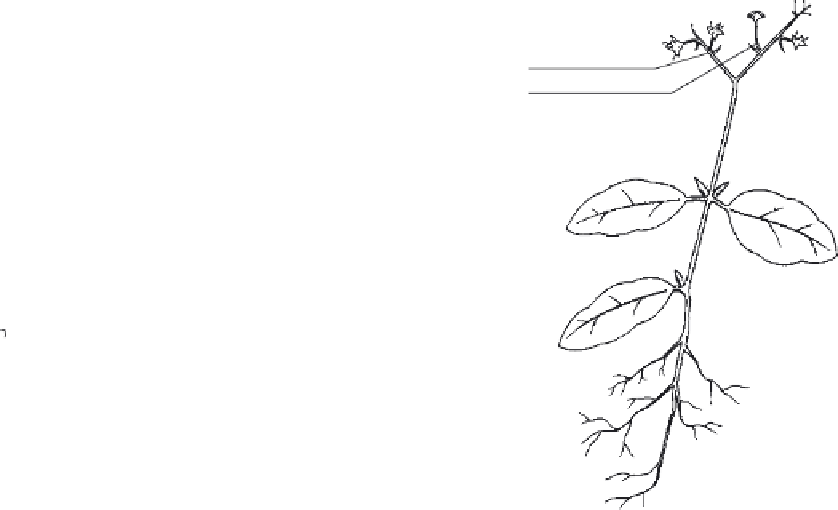Agriculture Reference
In-Depth Information
Flower bud
Spikelet
Flower
Bract
Pedicel
Stem
Petiole
Lamina
Inflorescence
Leaf blade
Midrib
Internode
Axillary bud
Node
Internode with a leaf sheath
enclosing the stem inside
Taproot
Tiller emerging from near
ground level
Fibrous roots
(a)
(b)
Figure 7.2.
Generalized plant forms: (a) a grass (a monocotyledon); (b) a dicotyledon
External features of roots, stems,
buds and leaves
Roots
While the internal structure of a plant organ can give
us an idea of its function and how it is designed to
carry out that function, it is the external appearance
of plant organs, the plant's morphology, with which
we are most familiar. Most plant species at first sight
appear very similar, since all four organs, the root,
stem, leaf and flower, are present in approximately
the same form and have the same major functions.
However, it is the differences in appearance of these
plant parts that enables us to distinguish between
them. An appreciation of how plant parts vary in their
size, shape, colour or other characteristics helps us
to correctly identify plants. See 'Plant Characteristics'
on the companion website. Furthermore, knowledge
of the terminology involved in describing plant
parts is invaluable in using plant keys as an aid to
identification. These are systematic lists of plant
characters which help to identify them through a
process of elimination. See 'Plant Identification Tools'
on the companion website. Finally, studying plant
form and appearance gives us a better understanding
of how they are adapted to their particular habitats.
Some basic terms used to describe the various plant
organs are shown for a generalized dicotyledon, and for
a grass as an example of a monocotyledon in Figure 7.2.
More detailed descriptions of the parts of flowers,
fruits and seeds are given in Chapter 8. The internal
structures of roots and stems are described in Chapter
6, and leaf structure, as an organ of photosynthesis, is
described in Chapter 9.
The main functions of the root system are to:
X
take up water from the growing medium
X
take up mineral nutrients from the growing
medium
X
anchor the plant in that medium.
To achieve maximum water and mineral uptake, roots
must have as large a surface area as possible. The
root hairs
, which can be seen just behind the root tip
(see Figure 6.8), greatly increase the root surface area
with as many 200-400 hairs per square millimetre.
The loss of root hairs during transplanting can check
plant growth considerably, and the hairs can be points
of entry of diseases such as club root (see p. 256).
Root hairs are replaced frequently as the root grows, a
single rye plant producing more than a million a day!
Two main types of root system are produced
(Figure 7.2). A
taproot
(primary root) is a single large
root which grows directly from the radicle (see p. 106)
in the embryo (Figure 7.3). It has many smaller
lateral
roots
(secondary roots) growing out from it at intervals.
Taproot systems are a distinctive feature of
dicotyledons (e.g. chrysanthemums, brassicas,
carrots). In contrast, a
fibrous
root system consists of
many roots with no dominant root (Figure 7.14c). It is
characteristic of monocotyledonous plants such as





















































































